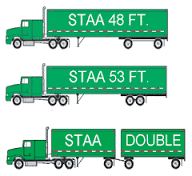Tell Caltrans that big trucks don’t mix with big trees, wild rivers & wetlands!
Caltrans has released a long-term planning document, called the Caltrans Transportation Plan (CTP) 2040. The agency opened a short comment period, which ENDS APRIL 17.
In keeping with our Put the Brakes on Caltrans campaign to put a halt to the environmentally disastrous plans on the north coast, we are submitting comments pertinent to those projects.
Please take a minute to send Caltrans comments. We need to tell Caltrans that Californians prioritize big redwoods, lush wetlands, threatened species and wild rivers over giant big rigs!
The link to submit comments is here: http://www.dot.ca.gov/hq/tpp/californiatransportationplan2040/public_review_form.shtml
You can simply cut and paste your comments or our suggestions into the form provided.
You can use our suggestions or peruse the 2040 Draft Plan and write your own comments. Remember that the more specifically comments address particulars in Caltrans’ Draft, the greater chance they will become part of the record and be taken into account.
The Public Draft Plan is here.
The CTP fact sheet is here.
We want to focus comments on these Caltrans projects on the north coast:

1. The project to widen and realign 197/199 in in Del Norte County Del Norte County
2. The Richardson Grove project on Highway 101 in Humboldt County’s redwoods
3. The Willits Bypass project on Highway 101 in Mendocino County
Caltrans lays out 6 goals; we focus on three that their actual plans contradict. Their stated goals run counter to the way they are implementing these three north coast projects. At best, the agency needs to be abolished and replaced, or at least overhauled in fundamental ways so that sound strategies are carried out for necessary and practical projects that benefit the state’s population and ecological values. Otherwise, their 2040 Plan is just words.
The Caltrans goals we chose to frame our comments:
G5: Foster Livable and Healthy Communities and Promote Social Equity
G6: Practice Environmental Stewardship
Suggested comments:
Addressing G4 to Improve Public Safety and Security
All three of these projects have the overarching goal that Caltrans rarely talks about: to make the coastal highway straighter and wider, and suitable for the oversized container trucks that already travel I-5 without modifications. It has been shown that the larger, over-sized trucks (known as STAA trucks) cause more accidents resulting in injury and death. This can be expected to hold true for all three north coast highway expansion projects, particularly along the narrow, winding stretches of Hwy. 101 and 197/199, and the curved,  elevated stretch of the Willits Bypass. The fact that this goal is being ignored exposes the fact that these projects are carried out under pressure from the trucking industry, not because the people of California need them. The STAA trucks belong on the interstate (I-5), not coastal roads!
elevated stretch of the Willits Bypass. The fact that this goal is being ignored exposes the fact that these projects are carried out under pressure from the trucking industry, not because the people of California need them. The STAA trucks belong on the interstate (I-5), not coastal roads!
As people ask for more bicycle and pedestrian access to areas like the redwood region, and as Caltrans states its intention to prioritize that access, to pave the way for oversized big rigs invites more pedestrian and bicyclist interfaces with large trucks.
Addressing G5 to Foster Livable and Healthy Communities and Promote Social Equity:
The Draft Plan states that “Solutions must support community aesthetics, the natural and built environment, and sustainable living” and further “balance cultural and historic values when addressing…impacts.” While rural character, agricultural lands and the protection of natural habitats are mentioned specifically, these goals contradict obvious project direction in the 197/199 Del Norte, Richardson Grove and Willits Bypass projects.
400 acres of agricultural lands are either lost to that use or damaged in the Bypass highway construction, with an additional 29 taken out of agricultural use for “mitigation” for loss of wetlands acres, with most of those acres farmed by small family farmers.
Many of the large number of archaeological sites and artifacts have come to light via “discovery by bulldozer.” Subsequently, local Tribal groups have been stonewalled in many attempts to have consultations with Caltrans. This treatment of the resources and Tribal people contradicts a stated goal to ensure preservation of “culturally sensitive Native American…resources.”
Flying in the face of the goal to support the natural environment are their many Water Quality violations seriously impacting the natural habitat of Haehl Creek, which support Coho Salmon, in the Bypass Project. While that project is well underway, the natural environment threats inherent in the Richardson Grove and 197/199 projects include rare and threatened species and habitat, including old growth redwood forest, Coho salmon and other aquatic species, and potential habitat for species dependant upon ancient redwood forests like the marbled murrelet, red tree vole, and other species in recovering populations that could return to historic habitat areas, but not if those areas are destroyed or “converted.” In Willits, the loss of 80 acres of wetlands is an ecological travesty, considering that California has lost 95% of its wetlands already. The proposed mitigation plan is risky and unproven at best.
Addressing G6: Practice Environmental Stewardship
According to the Advocates for Highway and Auto Safety, increases in truck size (with bringing more STAA trucks to northern California’s coast highways) have never resulted in fewer trucks on the road. Yet some of the problems caused by more of the larger trucks on the road include
greater fuel use and more greenhouse gas emissions.
While Caltrans, in their 2040 Plan recognizes the importance of addressing climate change and greenhouse gas emissions, and acknowledges that transportation use is the largest source of CO2, accounting for almost 40% of GHG emissions in California (from the CT 2040 Draft Plan), bringing more larger trucks onto the road, thereby increasing emissions, runs counter to any goal of reducing GHG emissions.
Moreover, AB 32 requires that the 2020 total greenhouse gas (GHG) meet the emissions level of 1990, and by 2050 be 80% below the 1990 level. While Caltrans admittedly has some seemingly sound proposals for emission reductions for urban areas, the direction of these three north coast projects run counter to the stated goals.
Given the finite nature of budget dollars, it serves the people of California to layer a clear priority ranking for projects in the state. With regard to coastal Northern California, there are sorely needed infrastructure repair projects that stand waiting to be budgeted. An example is “Last Chance Grade,” near Crescent City, a geologically unstable slide area on Highway 101 made more hazardous by last summer’s fires in the Klamath N.F.
It also serves the public trust, economies of rural Northern California and the invaluable natural environment to halt and discontinue these projects that are based on outmoded models, values and culture of transportation planning and prioritize forward-moving projects that keep systems working without devastating costs to the ecology.


